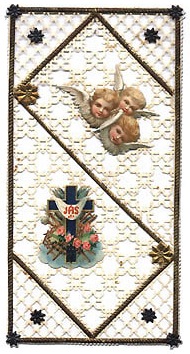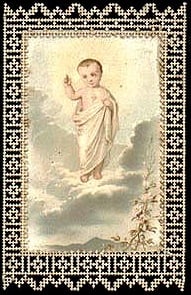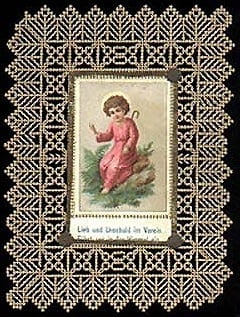- Threads & Yarns
- Fabrics
- Accessories & Haberdashery
- Books and Magazines
- Cross Stitch Charts
- Kits
- Ready to Stitch
- Beads, Charms, Buttons
- Batting and Interfacing
- Tilda
- Ornaments, Paper, Colors
- Fashion & Living
- Manufacturers
- Events
- Christmas
- Halloween
- Valentine's Day
- Easter
- Items to explore
- Hard to Find
Products
Close
Canivet: the ancient paper art
Date Added: 07/21/2009 With this job (which is a privilege for me, since, more than a job, it's a passion to share), it happens sometimes that you catch up with something absolutely new...
With this job (which is a privilege for me, since, more than a job, it's a passion to share), it happens sometimes that you catch up with something absolutely new... Or, better said, something that's new for me, though it's not new at all... I know: it sounds a little tortuous, but keep reading and I'll explain everything
 Just a couple of days ago, I was pleased to get some emails from a very kind gentleman a customer of ours called Vincenzo, who was looking for some perforated paper for an ancient art - though, as already said, absolutely new for me - which he devotes himself to, with great passion and knowledge (as you can understand from the explanations he kindly gave me about it): the Canivet.
Just a couple of days ago, I was pleased to get some emails from a very kind gentleman a customer of ours called Vincenzo, who was looking for some perforated paper for an ancient art - though, as already said, absolutely new for me - which he devotes himself to, with great passion and knowledge (as you can understand from the explanations he kindly gave me about it): the Canivet.So, I said to myself: "how could I ever leave such a beautiful form of art closed in these emails?"... I thought it would have been a shame: just like when you receive a wonderful present and you keep it all for yourself, without showing it to anybody!!! I've never been able to - I konw, you'll probably think I'm a little "exhibitionist"... But is it so wrong, after all, when it comes on somoething so beautiful and rare? In this case, why not?!?!?!?!???? - so, here are some news about this Canivet, its origins and success, just as Vincenzo gave them to me. And, by the way, thanks Vincenzo for surprising me so much!
 The Canivet is an art connected to small holy pictures and it was probably born in France, in the 13th century approx. With this craft, the holy pictures are realized in a sort of needlework on a light perforated paper with an as perforated edge, forming a lace. Just imagine the difficulty of depicting some figures of Saints in such small miniatures in this way
The Canivet is an art connected to small holy pictures and it was probably born in France, in the 13th century approx. With this craft, the holy pictures are realized in a sort of needlework on a light perforated paper with an as perforated edge, forming a lace. Just imagine the difficulty of depicting some figures of Saints in such small miniatures in this way  And, in fact, in Italian we have a way of saying that sounds more or less like this: "it takes the patience of a Carthusian monk" (in English, it should be the patience of Job!), just because craft works like this were left almost exclusively to the hands of monks and nuns in medieval monasteries and convents! They used to craft them as an expression of Christian faith and spiritual exercise, going beyond prayers. Today, what drives the fans of this art, such as Vincenzo, is maily the satisfaction they get from paper: an apparently poor material, but, on the contrary, an extraordinary and very versatile one, as Vincenzo, again, has confirmed: "I remember me as a child, always cutting and pasting some paper! It's a wonderful material, giving you extraordinary tactile and visual sensations".
And, in fact, in Italian we have a way of saying that sounds more or less like this: "it takes the patience of a Carthusian monk" (in English, it should be the patience of Job!), just because craft works like this were left almost exclusively to the hands of monks and nuns in medieval monasteries and convents! They used to craft them as an expression of Christian faith and spiritual exercise, going beyond prayers. Today, what drives the fans of this art, such as Vincenzo, is maily the satisfaction they get from paper: an apparently poor material, but, on the contrary, an extraordinary and very versatile one, as Vincenzo, again, has confirmed: "I remember me as a child, always cutting and pasting some paper! It's a wonderful material, giving you extraordinary tactile and visual sensations". The present canivet paper is actually an evolution of the parchment used to make these holy pictures some centuries ago and, unbelievable, in an online auction I've just found out that one of this ancient holy pictures was sold for more than 800 euros, and it was probably a model realized on parchment, like those crafted by the nuns in the 18th century, with a small cutter called "canif", which they have taken their name "canivet" from. "They are very rare", again I was explained by Vincenzo. Today's canivet are base, as we have said a few lines above, on a special kind of perforated paper that was invented by the French publisher Bouasse-Lebel in the 19th century and, if you like the idea, just surf the Internet to see some examples of it: I'm sure, you there loving beautiful things so much, you'll be amazed just as I am
The present canivet paper is actually an evolution of the parchment used to make these holy pictures some centuries ago and, unbelievable, in an online auction I've just found out that one of this ancient holy pictures was sold for more than 800 euros, and it was probably a model realized on parchment, like those crafted by the nuns in the 18th century, with a small cutter called "canif", which they have taken their name "canivet" from. "They are very rare", again I was explained by Vincenzo. Today's canivet are base, as we have said a few lines above, on a special kind of perforated paper that was invented by the French publisher Bouasse-Lebel in the 19th century and, if you like the idea, just surf the Internet to see some examples of it: I'm sure, you there loving beautiful things so much, you'll be amazed just as I am 
Then, if you'd like to try this craft, we also have in stock the cartoncino perforato and two utili guide with many thrilling patterns to realize. In the meantime, just to get started, I'm very glad to publish some pictures of Vincenzo's works: thanks again Vincenzo and thanks to you all there, who will share your opinions with me!
See you soon!
Elena C.
Replies View ...

© Cenina S.r.l.
VAT : IT01651310516 - R.E.A. 128424
Fax: +39-0575-033115 - Tel: +39-0575-421407
E-Mail: [email protected]
VAT : IT01651310516 - R.E.A. 128424
Fax: +39-0575-033115 - Tel: +39-0575-421407
E-Mail: [email protected]

 English
English Français
Français Español
Español Italiano
Italiano